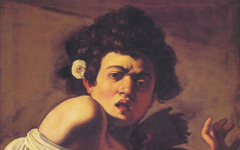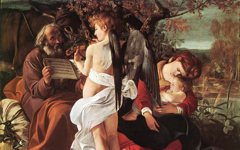Caravaggio’s David with the Head of Goliath (1610)
Caravaggio’s David with the Head of Goliath expresses art's underlying paradigm, every painter paints himself, in a clear and unmistakeable way. Accounts from the mid-seventeenth century report that both of the heads in the painting, Goliath's and David's, are self-portraits at different stages of the artist's life with the younger David described, somewhat oddly, as “his little Caravaggio.”1 No-one today, though, seriously doubts that Goliath's head is a self-portrait. Less recognized, though, is that Caravaggio clearly identified with the young David too whether or not he resembles the artist. Here's how.
If the painting itself is thought of as a mirror, David's gesture extending his arm out towards the surface resembles how a painter extends his arm towards a canvas when holding a paintbrush. In this case, however, he holds his own self-portrait in a concise rendering of art's underlying paradigm. Goliath's head, though, while clearly not a paintbrush can be considered David's (or Caravaggio's) own "painting", as Michael Fried has argued.2 Rembrandt's later Self-portrait with a Dead Bittern is a directly comparable picture with Rembrandt himself holding a dead bird towards us as an example of his painting.
There may also be some visual puns at work here. David has executed Goliath as an artist executes his painting but, in a further twist in Italian, a masterpiece is known as a capolavoro or, literally, head-work.
Click next thumbnail to continue
David’s weapon in the Biblical text was a sling but, like some earlier artists depicting the theme, he is shown with a sword. This cannot be a mere whim. Swords, as EPPH has shown, are often used as hidden symbols for a paintbrush because they are both long and thin. The sword's positioning also suggests an “erect phallus”, a traditional reference to an artist's mental conception of the image. Michelangelo, Titian and others often used similar sexual puns, as Maria Ruvoldt has shown, because for centuries sex and the production of art have been closely linked.3
Click next thumbnail to continue
Now, looking more closely, the fabric in the top left corner suggests that David has just entered Saul’s tent to show him the head. It appears to be night outside. The setting at night, inside a royal enclosure, is in my view an interior symbol for Caravaggio’s mind at the moment of insight. Moreover, in holding the head towards where Caravaggio the painter once stood, he may also be suggesting that at that moment he is the "king" as well, an ancient archetype of mental purity.
More Works by Caravaggio
Learn how a common pose in art carries specific meaning, regardless of subject matter

Over-the-Shoulder Poses
Notes:
1. Walter Friedlander, Caravaggio Studies (Princeton University Press) 1955, p.202
2. Michael Fried, The Moment of Caravaggio (Princeton University Press) 2010, p. 63
3. Maria Ruvoldt, The Italian Renaissance Imagery of Inspiration: Metaphors of Sex, Sleep and Dreams (Cambridge University Press) 2004, pp. 71-82; Eric F. Langley, “Anatomizing the early-modern eye: a literary case-study”, Renaissance Studies 20, June 2006, p.347; See also Abrahams, Michelangelo's Vatican Pieta and Abrahams, Michelangelo's Art Through Michelangelo's Eyes, Pt. 2, pp. 19-21
Original Publication Date on EPPH: 24 Jan 2011. | Updated: 0. © Simon Abrahams. Articles on this site are the copyright of Simon Abrahams. To use copyrighted material in print or other media for purposes beyond 'fair use', you must obtain permission from the copyright owner. Websites may link to this page without permission (please do) but may not reproduce the material on their own site without crediting Simon Abrahams and EPPH.





